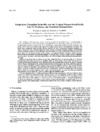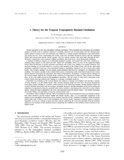Low-Frequency Transitions of a Simple Monsoon System
Abstract
Seasonal, diurnal and synoptic time scales, plus a subseasonal modulation" of synoptic events, appear
to dominate the temporal structure of monsoon systems. Observational studies indicate that the latter
low-frequency variation modulates or groups synoptic disturbances, producing periods of intense activity
(the "active" monsoon) separated by distinct lulls (the "break" monsoon). Together with the "onset" and
"retreat" ofthe monsoon, the modulations introduce into the system time scales which are far more rapid
than that which would be expected from the evolving latitudinal variation of insolation.
As observations indicate that the seasonal cycle and low-frequency transients occur in large spatial
scales a model is used which appears to simulate the large-scale mean seasonal structure of the monsoon.
Such a model is a zonally symmetric moist primitive equation model coupled to an interactive and mobile
ocean. With such a model the hypothesis is tested that the basic character of the low-frequency subseasonal
transients of the simple monsoon system are a result of feedbacks between the hydrologic cycle
and the differential heating between the interactive ocean and continental regimes.
With multi-annual integrations of the joint ocean-atmosphere model, monthly and daily variations are
studied with the aim of testing the hypothesis, With full hydrology and an ocean-continent contrast, the
model monsoon deviates substantially from the smooth transitions noted in dry experiments. Not only
do the onsets and retreats of the monsoon system accelerate but rapid, orderly transitions occur during
the Northern Hemisphere summer. During such transitions, the meridional monsoon cell periodically
migrates inland causing rising motion north of 30"N and subsidence near the coastal margin ,winch is the
location of mean seasonal ascent. The transition is seen to possess biweekly time scales and show some
characteristics of the monsoon "break". Similar transitions occur in subsequent years of the integration
and differ in timing and intensity but maintain the same basic period. Comparison of the results with those
of other studies are made and further studies detailed.
Rights
This publication is a work of the U.S. Government as defined in Title 17, United States Code, Section 101. Copyright protection is not available for this work in the United States.Collections
Related items
Showing items related by title, author, creator and subject.
-
Large-scale circulation variability over the tropical western North Pacific. Part II: Persistence and transition characteristics
Harr, P.A.; Elsberry, R.L. (American Meteorological Society, 1995-05-01);The variability of the large-scale circulation over the tropical western North Pacific is described within a framework defined by recurrent 700-mb circulation patterns that were defined by a fuzzy cluster analysis. Individual ... -
Western North Pacific monsoon depressions: formation, structure, and transition to tropical cyclones
Beattie, Jodi C. (Monterey, California: Naval Postgraduate School, 2015-09);Even though monsoon depressions are the synoptic precursors for a substantial fraction of the western North Pacific tropical cyclones, little is known about how they form. High resolution reanalyses, satellite imagery and ... -
A Theory for the Tropical Tropospheric Biennial Oscillation
Chang, C.-P.; Li, Tim (2000-07-15);The key questions of how the tropospheric biennial oscillation (TBO) maintains the same phase from northern summer in South Asia to southern summer in Australia, and how the reversed phase can last through three locally ...



 Choun_Low-Frequency_1979.pdf (913.8Kb)
Choun_Low-Frequency_1979.pdf (913.8Kb)

